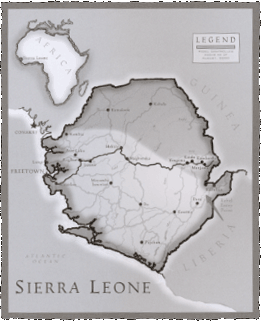M I C H A E L K A T A K I S
|
A T I M E A N D P L A C E B E F O R E W A R
Images and Reflections from a West African Town
 INTRODUCTION - This exhibition premiered at the Royal Geographical Society, INTRODUCTION - This exhibition premiered at the Royal Geographical Society,
London, May 2001
In 1991 rebel forces marched into Sierra Leone from camps in Liberia. As they moved toward the diamond fields of Kono more soldiers joined them. Thus began a nine-year civil war in which kidnapping, rape, mutilation and other atrocities became commonplace.
The Sierra Leone I knew was quite different. As an anthropologist I began recording the history and everyday lives of people in Kainkordu, a town in eastern Sierra Leone, in 1982. Now I find myself pouring over my notes, trying to understand how such violence could have happened there. What I see is a growing awareness of declines in education, health services, and economic opportunities. By 1988 bad roads made it nearly impossible to market crops, except for occasional illegal trade in Guinea. Kainkordu still had no power or running water. Teachers complained they were rarely paid and that books and writing materials were scarce. Students had little reason to try to advance because there were few jobs. By 1990 the United Nations Development Fund ranked Sierra Leone last among the world’s poorest countries. Life in rural areas had deteriorated to the point that the only avenue to a higher standard of living was illegal diamond mining. Some estimated that up to 80% of diamonds mined in Sierra Leone were exported illegally, leaving little to pay for schools, health care, roads, and other basic necessities. It is difficult to calculate how much of the money from diamonds was spent on weapons, or to trace the complex networks among diggers, middlemen, multinational corporations, and consumers that kept the diamond trade and the war going. As usual, though, it was the poorest people who suffered most.
Michael Katakis took these images in 1988. They are probably the last photographs taken of the area before the war began. Many of these people may be dead now and much of Kainkordu has been destroyed. Instead of romanticizing people’s lives, these photos record a time when people were unsure of what the future would bring. They remind us there is a cost for valuing greed and profit ahead of human life.
|
|
|
|